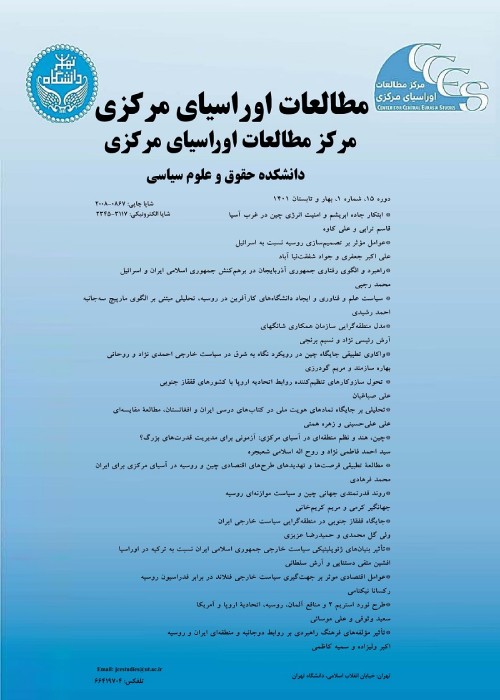Eurasian Economic Union and Regionalism of Iran
Regionalism is the expression of a common sense of identity and purpose combined with the creation and implementation of institutions that express a particular identity and shape collective action within a geographical region. Regionalism and regional convergence are one of the important mechanisms of countries for empowerment development in the new era. Russia is the largest and most powerful country which emerged after the collapse of the Soviet Union. This country has made many efforts in the last couple of decades to establish regionalism and regional arrangements in former Soviet republics, the results of which have been the establishment of the Eurasian Economic Union (EEU) which consists of Russia, Belarus, Kazakhstan, Armenia, and Kyrgyzstan. It is the most important and active union created after the dissolution of the former Soviet Union to foster closer economic cooperation among member states for the well-being of the people of the region. The Islamic Republic of Iran, which has always been excluded or has not entered into the regionalization processes in the peripheral areas of the East and West, has in recent years put cooperation and convergence with the Eurasian Economic Union on its agenda. The signing of the agreement on the Establishment of a Free Trade Zone between the Islamic Republic of Iran and the Eurasian Economic Union in May 2018 was an important step for Iran to enter into regional arrangements. The present study seeks to investigate the regionalism policies of the Islamic Republic of Iran and the Russian Federation. What are the goals of the two countries in converging and cooperating in the framework of the Eurasian Economic Union? Methods and Material: The field study of the research is the core of Eurasia. The Eurasian Economic Union is located at the eastern end of Europe, bounded by the Arctic in the north, the Pacific Ocean to the east and Eastern Asia, the Middle East, and parts of Central Asia to the south. The Eurasian Economic Union accounts for about 15 percent of the world's landmass, 2.4 percent of the world’s population, and 2.2 percent of the world’s gross domestic product or (GDP). The Islamic Republic of Iran is adjacent to the south of the Eurasian Economic Union. Iran shares borders with three of five countries of the Eurasian Economic Union. The research and data collection was done by descriptive and analytical methods. Results and Discussion The process of Eurasian integration began immediately after the break-up of the Soviet Union. When the USSR began to fell in 1991, the Commonwealth of Independent States (CIS) was created from the ruins of the former USSR. The idea of Eurasian regionalism dates back to 1994. In 1994, during a speech at Moscow State University, the first President of Kazakhstan, Nursultan Nazarbayev, suggested the idea of creating a “Eurasian Union”. The idea was pursued by Russia and Kazakhstan. With the beginning of Vladimir Putin’s era as a prime minister, Eurasianism politics and regionalism in Eurasia were followed by Kremlin. In 2000, five states of Belarus, Kazakhstan, Kyrgyzstan, Russia, and Tajikistan established the Eurasian Economic Community (EurAsEC). In October 2007, Russia, Belarus, and Kazakhstan signed an agreement to create a common customs territory and formed the Customs Union (CU). In December 2009, the leaders of the three countries in the city of Almaty signed the structure and framework of the Customs Union action plan for implementation from June 2010. The Treaty on the Eurasian Economic Union was signed on 29 May 2014 by the leaders of Belarus, Kazakhstan, and Russia, and came into force on January first, 2015. Finally, on January first, 2015, the Treaty on the Eurasian Economic Union took effect. The treaty codified and expanded all prior agreements regarding both the work of the Customs Union and the development of additional areas of integration. Armenia joined the integration union on January 2nd, 2015, and Kyrgyzstan joined on May 8th, 2015. The Member states established the EAEU based on a certain understanding of their long-term economic objectives. Establishing a single market for trading goods, services, capital deployment of labor forces among member states and has the specific and highly ambitious goals of creating a customs union. The Interim Agreement enabling the formation of a free trade area between the Eurasian Economic Union (EAEU) and the Islamic Republic of Iran was signed in May 2018 within the framework of the Astana Economic Forum. The objectives of the Agreement are to liberalize and facilitate the trade of goods between the parties through, inter alia, reduction or elimination of tariff and non-tariff barriers concerning the originating goods included in Annex 1 of the Agreement; to create a base for formation of a free trade area in which following international rules, standards and practices, duties and other restrictive regulations on commerce will be eliminated between the Parties and the necessary support for economic and trade cooperation between them will be provided. From the date of the entry into force of this Agreement, the parties will reduce and/or eliminate customs duties on goods listed in Annex 1 of this Agreement. According to Annex 1, in the Agreement, the list of 502 goods and services by the Eurasian Economic Union and 360 items in similar cases by Iran are included. With the policy of Eurasianism, Russia seeks to expand its sphere of influence and rebuild its status as one of the world powers. The Islamic Republic of Iran has realized the importance of regionalism, but it has been left out or not included in almost all processes of regionalism in the East and the West. Iran sees the Eurasian Economic Union as an opportunity to expand its international relations and strengthen its economy during the sanctions period. Conclusion The US withdrawal from the Joint Comprehensive Plan of Action (JCPOA) and the extensive US sanctions against Iran and also Russia’s geopolitical straits and the challenge to the West, have led Russia and Iran to cooperate within the framework of the Eurasian Economic Union. The results show that despite the economic nature of the agreement, its political and geopolitical goals are of high importance for both Russia and Iran.
- حق عضویت دریافتی صرف حمایت از نشریات عضو و نگهداری، تکمیل و توسعه مگیران میشود.
- پرداخت حق اشتراک و دانلود مقالات اجازه بازنشر آن در سایر رسانههای چاپی و دیجیتال را به کاربر نمیدهد.



